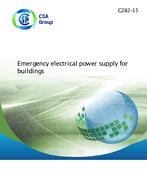CSA C282-15
Preface
This is the sixth edition of CSA C282, Emergency electrical power supply for buildings. It supersedes the previous editions published in 2009, 2005, 2000, 1989, and 1977. The main changes from the previous edition are as follows: a) addition of a note to Clause 1.1 to provide clarification for electrical power supply systems designed and installed to operate for purposes other than those specified in the Scope of this Standard. b) definitions have been added and revised (see Clause 3); c) rating requirements have been revised (see Clause 5.2); d) the minimum engine generator set full-load rating has been revised for Class A or Class B HCF and Class C HCF and non HCF buildings (see Clause 6.1.1.2); e) cooling system requirements have been revised (see Clause 6.1.2); f) the location of the emergency electrical supply has been clarified (see Clause 6.2.1); g) generator layout and working space have been clarified (see Clause6.5); h) provisions for load testing have been added (see Clause 6.15); i) the LTP term for maximum power rating of generator set has been replaced (see Clause 7); j) pollution compliance requirements for exhaust gases of generator sets have been clarified (see Clause 7.2.1); k) fuel supply and storage requirements have been clarified (see Clause 7.3); l) the power for starting and storage batteries capacity has been clarified (see Clause 7.6); m) requirements for overcurrent devices have been clarified (see Clause 8.7); n) requirements for automatic transfer of supply power have been clarified (see Clause 9.4); o) requirements for manual bypass switch have been clarified (see Clause 9.5) p) annual testing requirements have been clarified (see Clause 11.3); q) inspection requirements for different battery types clarified (see Table 2); r) inspection requirements for all electrical components and battery charger current output have been added (see Table 3); s) inspection requirements for overcurrent protective devices have been revised (see Table 5); t) requirements for infrared thermal imaging assessment have been clarified (see Table 6); u) guidelines for appropriate minimum full load rating and sizing of generator sets have been clarified (see Clause B.3); v) additional guidelines for location of generator sets in areas that might be susceptible to flooding have been revised (see Clause B.5); w) guidelines for location of electrical connections within the emergency power distribution system for fuel transfer pumps and other auxiliary equipment essential for reliable operation of the emergency power system have been revised (see Clause B.16); x) guidelines for the use of electrical power supply equipment for powering non-life safety loads have been added (see Annex E); and y) guidelines for selection of generator set battery charger have been added (see Annex F). This Standard is considered suitable for use for conformity assessment within the stated scope of the Standard.
Scope
1.1 This Standard applies to the design, installation, operation, maintenance, and testing of emergency generators and associated equipment for providing an emergency electrical power supply to electrical loads a) in buildings and facilities when the normal power supply fails and an emergency electrical power supply is required by the National Building Code of Canada (NBCC); and b) of essential electrical systems, where emergency generators are intended for use in health care facilities (HCFs) in accordance with Clause 6 of CSA Z32. Notes: 1) For guidelines on emergency electrical power supply for life-support equipment, see Annex A. 2) In this Standard, the term “building” also includes facilities. 3) Normative provisions of this Standard are not limited to the installations where an emergency generator is used as the NBCC required emergency power supply source to the “life safety equipment”. 4) For guidelines on the use of emergency electrical power supply equipment for purposes beyond the provisions of Clause 1.1, see Annex D. 5) It is intended by the scope of this Standard that equipment other than “life safety equipment” could be connected to the emergency generator (see Clause 6.4.1). 6) For electrical power supply systems designed and installed to operate for purposes other than those specified in Clauses 1.1, the electrical power supply system should meet the requirements of this Standard, where practical, and in conjunction with the guidelines of Annex E of this Standard. 1.2 This Standard does not cover a) any emergency electrical power supply provided from storage batteries or other sources of uninterrupted power supply (UPS); and b) design and construction of unit equipment for emergency lighting that complies with CSA C22.2 No. 141. 1.3 In this Standard, “shall” is used to express a requirement, i.e., a provision that the user is obliged to satisfy in order to comply with the standard; “should” is used to express a recommendation or that which is advised but not required; and “may” is used to express an option or that which is permissible within the limits of the standard. Notes accompanying clauses do not include requirements or alternative requirements; the purpose of a note accompanying a clause is to separate from the text explanatory or informative material. Notes to tables and figures are considered part of the table or figure and may be written as requirements. Annexes are designated normative (mandatory) or informative (non-mandatory) to define their application.
Product Details
- Edition:
- 6th
- Published:
- 03/01/2015
- ISBN(s):
- 9781771398565
- Number of Pages:
- 68
- File Size:
- 1 file , 1.7 MB
- Redline File Size:
- 2 files , 8.3 MB
- Product Code(s):
- 2423506, 2423847, 2423506, 2423506
